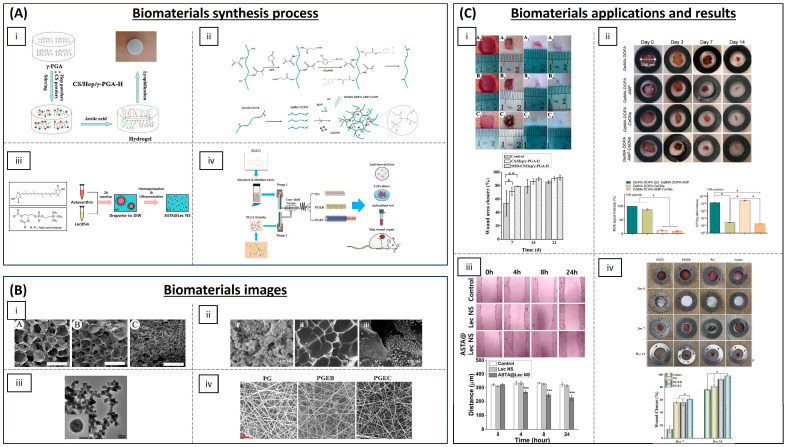Figure 4.
Salient biomaterials currently used for the treatment of chronic wounds. (A) Synthesis process of the biomaterials. (i) Preparation of CS/Hep/γ-PGA composite hydrogels [61]. (ii) Synthesis reaction for the preparation of CeON-loaded GelMA-DOPA hydrogel [65]. (iii) Development of astaxanthin-loaded lecithin nano-liposol (ASTA@Lec NS) [77]. (iv) Preparation of electrospun PLCL/gelatine nanofibre membranes (NM) (PG, PGEB and PGEC) [81]. (B) Biomaterials images. (i) SEM images of CS/Hep/γ-PGA hydrogels with different ratios of synthesis: A: 10/1/9, B: 10/3/7 and C: 10/5/5 (from left to right) (scale bar: 1 mm) [61]. (ii) SEM observation of CeONs (left (i)) and CeON-loaded GelMA-DOPA hydrogel (middle (ii) and right (iii)) [65]. (iii) Transmission electron microscopy (TEM) image of ASTA@Lec NS (scale bar: 200 nm) [77]. (iv) SEM image of the different nanofibre membranes synthesized (scale bar: 8 μm) [81]. (C) Wound healing results of the biomaterials. (i) Zhang L. et al. showed that the wounds treated by SOD-CS/Hep/γ-PGA-H (middle) showed a better closure ratio of 92.0% ± 3.7% versus those of the control group (top) (85.4% ± 2.4%) and the same hydrogel without SOD (bottom) (89.8% ± 2.8%) at days 7, 14 and 21 (left to right). The graph shows the wound closure rate (n = 3). * p < 0.05; ** p < 0.01 [61]. (ii) Cheng H et al. determined the healing speeds of the skin defects treated with different GelMA-DOPA-based hydrogels. It was found that GelMA-DOPA-AMP-CeONs facilitated the most rapid healing in the defect areas, followed by the GelMA-DOPA-AMP and GelMA-DOPA-CeONs groups. The left graph shows a decreased in vivo ROS detection of the wound covered with GelMA-DOPA-based hydrogels at day 2 than controls. The right graph demonstrated the antimicrobial effect of the synthesized hydrogel. * p < 0.05 [65]. (iii) Oh H et al. showed that the scratch distance of the ASTA@Lec NS-treated cells decreased from 324 ± 6 μm to 227 ± 19 μm after 24 h of treatment; however, scratch distance of the control group and the group without ASTA exhibited almost no change from that of the initial distance. *** p < 0.001 [77]. (iv) Li A et al. demonstrated that the highest wound closure rate was observed in the group treated with PGEC (98%), whereas the gauze treated group showed the least wound closure rate. * p < 0.05 [81]. All images reproduced with permission. Images (A(i),B(i),C(i)) [61] 2012, Elsevier. Images (A(ii),B(ii),C(ii)) [65] 2021, Elsevier. Images (A(iii),B(iii),C(iii)) [77] 2020, Oh H et al. Images (A(iv),B(iv),C(iv)) [81] 2022, Elsevier.

